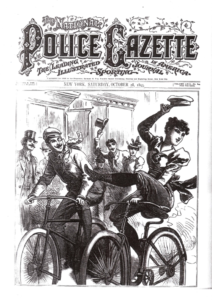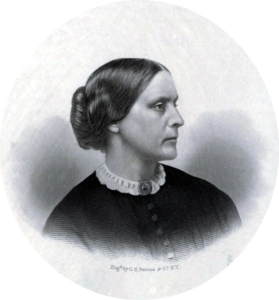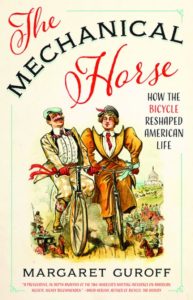
With a mere three weeks to go before the Historic Riverton Criterium returns to the streets of Riverton, we remind readers that a previous post explained that women cyclists first competed in the 2015 Historic Riverton Criterium.
In cycling, as in other areas of sports, women have often been forbidden to compete in major contests. Men had their first Olympic Games cycling race in 1896, but women had to wait until 1984 for the first women’s Olympic road race.
Witnessing the determined women competing in high performance women’s cycling apparel, it may be hard to imagine a time when Victorian attitudes and long skirts made it difficult, if not impractical, for women to enjoy bicycling at all.

Indeed, a popular thesis is that the late 19th century bicycle craze helped liberate women.
The story of Angeline Allen may serve as an example.
In 1893, Angeline Allen of Newark, NJ, created a sensation when she rode a bike through town wearing blue corduroy bloomers.
This brazen act was met with astonishment, derision, and a public scolding in the newspapers.
They were just pants!
But in a world where customs and laws restricting this manner of dress sometimes still criminalized such behavior even into the early 1900s, this was a brave act in reforming women’s fashion.
Today’s women cyclists owe a debt to the legacy of Angeline Allen and Annie Londonderry for moving the ball forward in the struggle for women’s rights.

In 1896, suffragist Susan B. Anthony observed, “Let me tell you what I think of bicycling. I think it has done more to emancipate women than anything else in the world. It gives women a feeling of freedom and self-reliance. I stand and rejoice every time I see a woman ride by on a wheel…the picture of free, untrammeled womanhood.”
Society, and bicycles, may have evolved since then, but to see how far, we will leave it to author Margaret Guroff to tell more about Miss Allen and explain how we got to this point.
In her recent book, The Mechanical Horse: How the Bicycle Reshaped America Life, Guroff also examines how the invention of the safety bicycle ignited other changes in society – the development of better roads and changing attitudes of consumers, for example.
 The website Longreads provides an excerpt from Guroff’s book entitled, The Mechanical Horse: How the Bicycle Reshaped America Life, in a chapter called “The Wheel, the Woman, and the Human Body.”
The website Longreads provides an excerpt from Guroff’s book entitled, The Mechanical Horse: How the Bicycle Reshaped America Life, in a chapter called “The Wheel, the Woman, and the Human Body.”
In this interview of the author we learn that finding out the role that bikes played in paving roads got her started, but her book also explores the bike’s influence on many other aspects of American life.
This amazon.com book blurb allows a peek inside other parts of her lively cultural history book.
As you enjoy the races on June 9, remember the history that got us to this moment.
